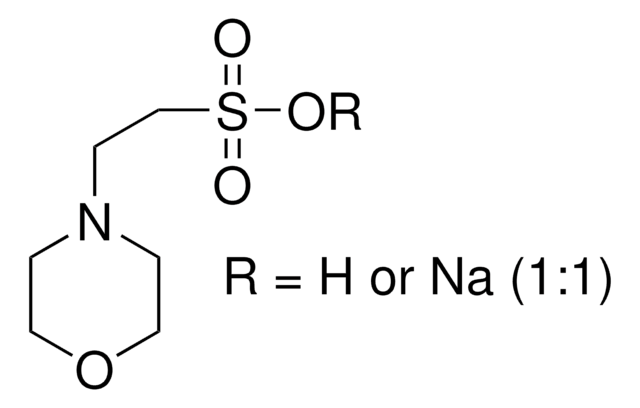RES0114M-A7
MES sodium salt
Sinónimos:
Ácido 2-(N-morfolino)etanosulfónico sodium salt, Ácido 4-morfolinoetanosulfónico sodium salt
About This Item
Productos recomendados
origen biológico
synthetic
Nivel de calidad
Formulario
powder
técnicas
cell culture | mammalian: suitable
impurezas
Endotoxin and microbial, tested
intervalo de pH útil
5.5-6.7
pKa
6.1
idoneidad
suitable for manufacturing use
actividad extraña
Cytotoxicity, DNase, NICKase, RNase, and Protease; tested
cadena SMILES
[Na+].[O-]S(=O)(=O)CCN1CCOCC1
InChI
1S/C6H13NO4S.Na/c8-12(9,10)6-3-7-1-4-11-5-2-7;/h1-6H2,(H,8,9,10);/q;+1/p-1
Clave InChI
IRHWMYKYLWNHTL-UHFFFAOYSA-M
¿Está buscando productos similares? Visita Guía de comparación de productos
Descripción general
M-Clarity Program
Buffer quality is vital for the success of biopharmaceutical processes, because buffers are indispensable in nearly every production step.
Our broad portfolio of buffer materials manufactured under appropriate controls is tailored to your needs. Ranging from non-GMP grades for low-risk application, to IPEC-PQG GMP for higher-risk applications, we have products covering all your manufacturing needs.
Aplicación
MES Sodium is used in cell culture media, biopharmaceutical buffer formulations both upstream and downstream and diagnostic reagents. MES based buffers are used in purification bioprocesses of antibodies, peptides, proteins and blood components.
Envase
RES0114M-A701X: 100g container
RES0114M-A702X 1kg container
RES0114M-A704X: 10kg container
RES0114M-A705X: 25kg container
Información legal
sustituido por
Código de clase de almacenamiento
11 - Combustible Solids
Clase de riesgo para el agua (WGK)
WGK 1
Punto de inflamabilidad (°F)
Not applicable
Punto de inflamabilidad (°C)
Not applicable
Elija entre una de las versiones más recientes:
¿Ya tiene este producto?
Encuentre la documentación para los productos que ha comprado recientemente en la Biblioteca de documentos.
Los clientes también vieron
Nuestro equipo de científicos tiene experiencia en todas las áreas de investigación: Ciencias de la vida, Ciencia de los materiales, Síntesis química, Cromatografía, Analítica y muchas otras.
Póngase en contacto con el Servicio técnico









